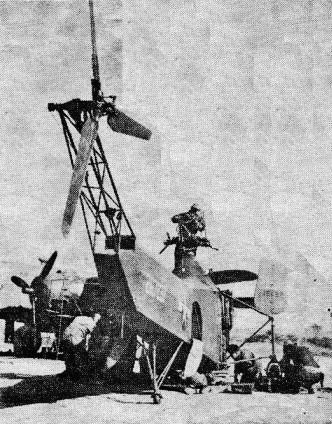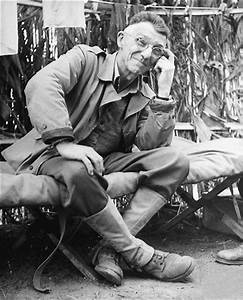Blog Archives
C.B.I. Theater – June 1945 (2)

Assembling the helicopter at Myitkyina. Shortly after, it would land on a Burma peak for the 1st such mercy mission in this area.
AAF HQ. – Capt. Frank W. Peterson maneuvered the helicopter through the maze of jungled Burma peaks and set the small ship down on a rough strip atop a razorback mountain whose sides fell off steeply to narrow valleys 2,500 feet below.
Twenty-four hours later, after gas and oil had been air-dropped, he took off again, this time carrying a passenger: 21-year-old Pvt Howard Ross, ground observer at an isolated weather station outpost in North Burma who was suffering from a badly infected gunshot wound in his hand.
This air evacuation mission, marking the first time a helicopter had been employed in rescue work in this Theater, climaxed one of the most amazing stories to come out of India-Burma. The story had its beginning when, after the forced landing of a B-25 on an isolated mountain-top in Burma, it was determined that a helicopter would be necessary to effect the rescue of the bomber crew, none of whom were injured. The request was made by radio to Army Air Forces Headquarters in Washington.
A crew at Wright Field, Ohio, was ordered to begin the dismantling of a helicopter and, working all night, loaded it upon a C-54 cargo plane by the following morning. meanwhile, Peterson, a Wright Field test pilot was ordered to accompany the engineering crew to Burma.
Four days later, the C-54 with its rescue mission cargo landed at Myitkyina, only to learn that the men they had been rushed overseas to rescue had already been evacuated. It was decided, however, to continue with the assembly of the helicopter as rapidly as possible in the event another emergency should arise.
Late that night, Lt. Leo J. Kenney, commanding officer of the jungle rescue unit, awakened Peterson and told him that a member of a weather station located high on a 4,700-foot mountain in the Naga Hills, with a gun shot wound. With medical aid 10 days distant by mountain trail, air rescue had to be attempted despite the inaccessibility of the station even to parachute jumping.

Pilot Erickson & Igor Sikorsky test the Sikorsky R-4, 1942 The following morning the rescue mission took off. Since the helicopter was not equipped with radio and Peterson and Lt. Irwin C. Steiner, another veteran pilot from Wright Field who accompanied Peterson, were flying over unfamiliar territory, the rescue ship was escorted by two L-5’s piloted by T/Sgt. William H. Thomas and S/Sgt. Gibson L. Jones.
Four times, the helicopter became separated from its guide planes, a low ceiling having enveloped the mountain country. But each time the planes renewed contact. Once the helicopter made three attempts before finally topping a 5,000-foot mountain peak. Another time, the ship ran out of gas and had to make a forced landing on a sand bank in the Chindwin River, where Peterson and Steiner sat down and waited for fuel to be air-dropped from the L-5’s. Up in the air once more, the helicopter climbed up over rocky peaks which jutted sharp above matted jungle, finally landing at the crude air-drop field near the weather station just before running out of gas again. The next day, nine days after engineers began disassembling the helicopter at Wright Field, Peterson flew the wounded man out of the jungle.
***** ***** *****

General Joseph “Vinegar Joe” Stillwell, commander of U.S. Armies in the China, Burma, and India Theater, proudly wears his newly received four stars on his collar and the tag on his jeep. October 26, 1944. He was recently promoted to the rank of Full General.(AP Photo)
Uncle Joe Stilwell has returned to the grim but satisfying business of killing Japs – as Commanding General of the U.S. 10th Army, which this week annihilated the remnants of enemy opposition on bloody Okinawa.
Okinawa’s soil today contains the mortal remains of Lt. Gen. Simon Boliver Buckner, Jr., the colorful commander who led the new 10th Army ashore last Easter Sunday. In their last hour of military triumph, G.I.’s and his ranking officers reverently buried the general beside the men of the Seventh Division.
The nation applauded the move that placed four-starred Uncle Joe in command of the 10th Army. While in Chungking and India, Stilwell helped plan and carry out the liberation of North Burma and the building of the Ledo Road which later took his name.
Subsequent differences of opinion with Chiang Kai-shek led last October to Uncle Joe’s recall to Washington where he was given command of Army Ground Forces.
Stilwell carried out his job with AGF with determination and spirit, bit no one doubted that it was his prayer to be returned to a combat assignment against the Japanese.
The death of Buckner brought to 34 the number of U.S. generals lost from all causes in action thus far in World War II, including four lieutenant generals. Shortly after the 10th Army Commander was killed, Brig. Gen. Claudius M. Easley, assistant commander of the 96th Infantry Division on Okinawa, also died in action.
Click on some of the images to enlarge.
############################################################################################
Military Humor – CBI Style –
############################################################################################
Farewell Salutes –
Timothy Bolyard – Thornton, WV; US Army, Afghanistan, Sgt. Major, KIA
John Breitmeyer – Christchurch, NZ; RNZ Navy # NZ9045, WWII
Warren Foss – St. Louis, MO; US Navy, WWII, PTO
Helmer Holmberg – Brn: SWE; Swedish Army, WWII
John Innes – Brisbane, AUS; Civilian, Pacific War Historian eg: “Guide to the Guadalcanal Battlefields”
Ruth Mesich – Wakefield, MI; US Navy WAVE, WWII
Millard Odom – Bateville, AR; USMC, WWII, PTO, Sgt., 3/2nd Marine Regiment, KIA (Tarawa)
Vinnie O’Hare – Broad Channel, NY; US Army, WWII
Robert Prata – Brooklyn, NY; US Army, Vietnam
Roy Stilwell Jr. – Chicago, IL; US Army Air Corps, WWII, PTO, 13th Air Force
#########################################################################################################









